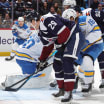ARLINGTON, Va. -- The Washington Capitals have learned during the first three games of the Eastern Conference Final that the quickest way for them to lose control of the series is to take penalties.
Solving, or even slowing, the Tampa Bay Lightning power play is proving to be a difficult challenge. The Lightning scored on their first two power plays in a 4-2 Game 3 win Tuesday.
Capitals focused on improving penalty kill for Game 4 against Lightning
Washington must take fewer penalties, find balance in defending Stamkos, Kucherov, Hedman

RELATED: [Complete Lightning vs. Capitals series coverage]
The Capitals lead the best-of-7 series 2-1 with Game 4 at home Thursday (8 p.m. ET; NBCSN, CBC, SN, TVA Sports) but know that lead won't last if they don't improve on the penalty kill.
"We'll be better. We have to be," said center Jay Beagle, who leads Capitals forwards in shorthanded ice time per game during the Stanley Cup Playoffs at 2:47. "It's unacceptable to let in that many [power-play] goals against our unit. It's huge to get a kill, it's a momentum boost, and we have to make sure that we don't accept it, that we strive to be better, because it's going to make the difference."
The Capitals penalty kill is at 74.5 percent during the playoffs, having allowed 14 goals in 55 times shorthanded, but it's been up and down. Washington opened the first round against the Columbus Blue Jackets by allowing two power-play goals on four chances in losing each of the first two games.
But a kill in overtime of Game 2 began a stretch that saw the Capitals kill 24 in a row extending into Game 3 of the second round against the Pittsburgh Penguins. Since then, their penalty kill has allowed 10 goals in its past 24 times shorthanded, a 58.3 percent success rate.
They'd previously been able to overcome those struggles, mostly because their power play is scoring at 30.8 percent (16-for-52) during the postseason, but they went 0-for-3 Tuesday. The Lightning power play went 2-for-5 in Game 3 and is 5-for-12 (41.7 percent) during the conference final.
"We've had a little stretch here where, just like the playoffs, you're going to have some ebbs and flows," Capitals coach Barry Trotz said. "We had a long stretch where nothing was going in and we've had a stretch here where they've scored a few goals in the first three games here. That can change in a heartbeat, just as the games do."
The simplest fix for the Capitals is to cut down on the penalties they're taking. They've been shorthanded nine times in the past two games and have allowed four power-play goals.
"There's no power play that works when they don't get them," Trotz said. "I thought some of our penalties last night were unnecessary, and because of that, that put the game at risk."
The first two penalties Washington took Tuesday -- goaltender Braden Holtby was called for tripping Lightning forward Yanni Gourde, and center Lars Eller received a minor for closing his hand on the puck -- could be categorized as unnecessary. Tampa Bay scored on each resulting power play.
"We need to be smarter and not give stupid penalties," Washington defenseman Dmitry Orlov said. "We know they have a good power play. They [converted] in all three games on the power play."
The Lightning power play is formidable because of the world-class weapons it possesses on its first unit, with forward Steven Stamkos and his right-hand shot in the left circle, forward Nikita Kucherov and his left-hand shot in the right circle, and defenseman Victor Hedman running things from the point.
Stamkos, who leads the playoffs with five power-play goals and 11 power-play points, has scored a power-play goal in each of the three games against Washington, each on a one-timer from the left circle. That's the spot Capitals forward Alex Ovechkin often scores from on their power play, so the look is familiar to Washington.
Having Kucherov, who has two power-play goals and nine power-play points during the playoffs, in the right circle presents a double-barreled problem for penalty killers.
"Those are some of the top two, top 10, in my opinion, goal-scorers in the League with those two guys," Capitals forward Alex Chiasson said. "Obviously they're going to get some of their looks."
The Capitals have yet to find the right balance between pressuring Hedman at the point and closing the passing lane through the slot between Stamkos and Kucherov. Each of Stamkos' power-play goals in the first two games came off a pass from Kucherov that went through the middle of Washington's penalty-killing diamond.
When the Capitals concentrated on closing that lane in Game 3, Hedman had more time and space to operate from the point. He fed Stamkos for his one-timer from the left circle that opened the scoring with 6:07 remaining in the first period and then went the other direction to set up Kucherov's one-timer that made it 2-0 at 1:50 of the second.
"The struggle right now is that balance," Beagle said. "We're going to go over it. I'm not going to give anything away. I'm not too sure, but we talked about it on the bench as the [penalty kill] unit and a little bit after the game and we know what we need to do."

















